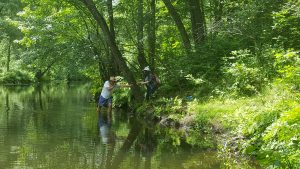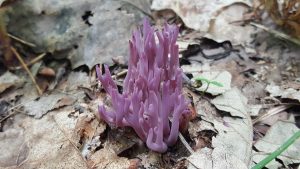On September 20th all Water Team hands were on deck to participate in a “Benthic Macroinvertebrate” study of the sites we monitor for water quality. “Benthic” means “bottom” and “Macroinvertebrates” are small aquatic organisms without backbones but visible to the naked eye.
What did we find? Roundworms, aquatic earthworms, leeches, sow bugs, clams and mussels, scuds, crayfish, mites, mayflies, dragonflies, damselflies, stoneflies, true bugs, alderflies, caddisflies, beetles, snails and limpets, midges, deer flies, mosquitoes, no-see-ums, craneflies, blackflies, and true fish.
Benthic macroinvertebrates are used as indicators of the biological condition of waterbodies. Healthy waterbodies support a high number of macroinvertebrate taxa.
Thanks to our benthic experts: Paula Madill and Carl Lesperance from Severn Sound Environmental Association, and Heather Wilton from Ontario Streams. Thanks to the Orillia Fish and Game Conservation Club for lending us their education centre for the day. Thanks to all the members of the Water Team – your efforts are helping to ensure that the water in our region remains swimmable, drinkable, and fishable.
Here’s a photo album from the day
Thanks to RBC Bluewater for making this day happen.
That’s a wrap for our summer Notes From The Field. Stay tuned for our Fall Notes. Happy Fall Equinox! May we have peace on our planet.

Volunteers learning about the Adam’s Nature Reserve from Ron Reid. Photo by David Hawke
On September 14th volunteers enjoyed a hike on the new Adams Nature Reserve acquired last December. Six of our volunteers were recognized for their long standing contribution to conservation this year by the Province of Ontario. We are very proud of their achievement, and to show our gratitude we enjoyed a hike guided by Ron Reid and David Hawke, followed by a cozy reception. Fun was had by all and we especially enjoyed the home made cake!
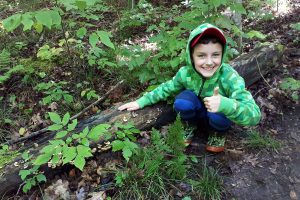
Photo by Dave Hawke,
On August 31 Stewardship Program Manager Dave Hawke and his grandson Toby went mushroom hunting at Grant’s Woods.In just over an hour they had found 57 species of fungi! The old growth character of the woodlot provides rich soils that are home to a great many mushrooms and related fungi. Please remember that collecting of mushrooms is not allowed on our properties.

John Pitts and Gerry Church at Kris Starr Sanctuary. Photo: David J. Hawke
On August 31st, Property Monitoring Team John Pitts and Gerry Church joined Stewardship Manager Dave Hawke to enhance the North-Side trail at the Kris Starr Sanctuary. This extended loop not only reaches the beaver pond, but a small natural meadow.

Lisa Neville and Dorthea Hangaard on the Roehl upland. photo: David J. Hawke
Sweet fern, Indian cucumber-root, Bristly Sarsaparilla, and the pellet of a Turkey Vulture were some of the highlights of a property monitoring visit to the Roehl Reserve August 29th.
This property is monitored by Conservancy members and volunteers Bill Darker (who donated the property in 1995 with his brother Dave) and Lisa Neville. Most of the 29 hectares is inaccessible wetland, but the upland traverse across Canadian Shield is filled with unique plants and great views, and is the main monitoring area for the team. See photos from the trip here

Photo by NCC Staff Brittany Hope
The past week has seen our Stewardship Manager Dave Hawke and NCC staffers Brittany Hope and Katie Cook scouring the Carden Plain looking for the invasive dog-strangling vine. This vine from Turnbull Ranch Nature Reserve was 8 feet long and had 187 pods. (You can imagine how quickly those 187 pods would spread!)
If you are interested in helping us fight these viney foes, join us as a volunteer
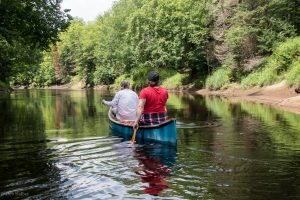
Paddlers on the Black River, photo by Deb Halbot.
To raise funds and awareness for our Black River Wildlands campaign The Couchiching Conservancy, with a ‘raft’ of volunteers and staff have been taking members of the public to see this beautiful property.
If you are interested in joining us for one of many bikes, hikes or paddles please click here for the full list of event details and registration.
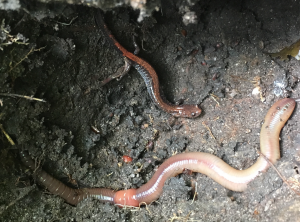
Eastern red-backed salamander compared to worm. Picture by Jordyn Burns
Another day another monitoring trip done by the Alexander Hope Smith Property Monitoring Team. The mosqitoes have calmed down since July (slightly) and the Eastern red-backed salamanders are still enjoying life in their soft, warm, muddy home. Here, you can see just how small they are compared to their huge roommate.
If you see any amphibians report them with the Ontario Nature Reptile and Amphibian Atlas! Learn more here.
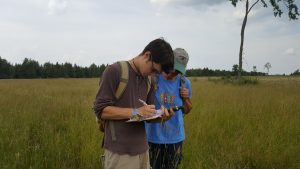
Grant Mask and Sue McIntosh – the new Bluebird Ranch property team. photo: Dorthea Hangaard
We decided that the heat and humidity of August 10th was perfect to orient the new Bluebird Ranch Property Monitoring Team of Sue McIntosh and Grant Mask. Adding to our discomfort, long pants and rubber boots are de rigueur for Alvar Field outings to thwart ticks and poison ivy. Sue and Grant were undeterred, enthusiastically snapping photos, asking great questions, and lingering to identify plants.
Sightings included Monarch Butterflies (at least six), Meadowlark, Wild Basil, and Dave Hawke’s worst enemy: Dog Strangling Vine. An approaching thunderstorm cut our visit short, but we know Sue and Grant will be back soon (on a cooler day) to complete the monitoring visit. If you would like to become a Property Monitor, visit our Volunteer section. No experience necessary!
Did you know that the Head River flows through the Kris Starr Sanctuary, beside the Monck Road? We’ve been waiting for water levels there to drop enough that its safe to establish a water quality monitoring team. Wednesday August 9th was the day, and as you can see it was a very fine day. Tom Wilson will now be monitoring this site regularly. On our first visit we found no trace of Nitrate-Nitrogen or Phosphates, but the river’s Alkalinity level is very low, giving it a reduced ability to buffer pollutants. Water temperature was 21 degrees, air temperature was 23.
Sure, the mosquitoes were “abundant” during our monitoring visit to the Alexander Hope-Smith Nature Reserve, but so were the mushrooms, fungi, and the Ghost Plant parasite.
On July 26th Dave Hawke led an orientation walk for this re-vamped Property Monitoring Team comprised of Jordyn Burns, Melanie Tuck, and Courtney Baker. Lorraine and Jerry Brown monitor the water quality in Boyd’s Creek, which flows through the property. Going forward, Courtney, Jordyn, and Melanie will conduct regular monitoring visits and report back on incursions, dumping of garbage, the state of the trails, and any Species at Risk or Invasives they encounter. To see more photos from the trip click here
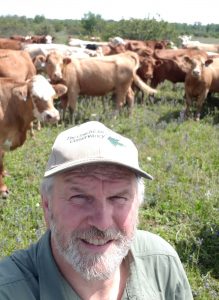
Dave Hawke’s first selfie with his new smart phone.
Stewardship Program Manager, Dave Hawke, hanging out with the local ‘gals’ in Carden. Cattle play an important role in grassland management. (July 20)

photo: Dorthea Hangaard
The Oro Moraine has some of the best drinking water in Ontario. Many springs bubble up from the forest floor cold and clear, and merge to form significant rivers, such as the Coldwater. East Coulson Swamp, owned by the Nature Conservancy of Canada, is home to one of these groundwater discharge areas. On July 5th, our water team began monitoring this important water source. Our tests revealed a stable pH and an off-the-chart alkalinity level, which means it is able to neutralize acidity easily. The forest was filled with many bird songs including Red-Shouldered Hawk, Black Throated Green Warbler, and Scarlet Tanager.
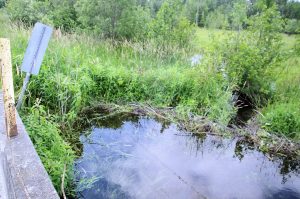
photo: Bill Sherwood
If there’s one animal that we ought to celebrate for Canada’s 150th birthday it’s the beaver. No other animal, except humans, has shaped the Canadian landscape so dramatically.Why do we have so many rivers that they could circle the globe 400 times? Largely because of the beaver. Bill and Vicki Sherwood can attest to this. When they showed up at their water testing site on June 27th, there was a beaver dam! These natural dams can be a great buffer against droughts, holding water upstream longer. Happy Canada Day, beavers!
“I had watched fat little beavers sitting up like queer diminutive Buddhas on a river bank, solemnly wagging their heads at the rising sun, while the mother lay by and crooned at them, plucking them towards her at intervals and rolling on her back from time to time, murmuring with contentment, happy with her young and the sheer joy of living.” – Grey Owl, Pilgrims of the Wild
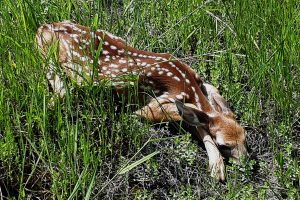
photo: David J. Hawke
Stewardship is not always about letting things be and grow as they are. Sometimes we have to take serious action on threats to our landscape like invasive species. The first week of summer our Stewardship Program Manager was in the field culling Dog Strangling Vine to make room for native plants to thrive. While working on Bluebird Ranch he came across this sleepy little fawn. Isn’t she darling? Isn’t she beautiful? Isn’t she worth protecting? To help these species thrive, try to avoid planting invasive species and report those you find. They can wreak havoc on the ecosystem that fawns like these call home.


